
Canada’s armed forces are battling decades of neglect. From ships to soldiers, here’s how to shape up
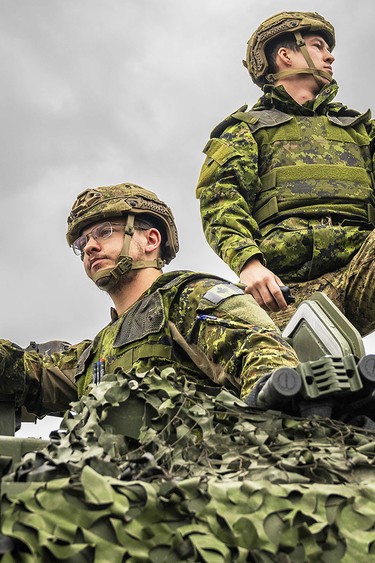
Article content
The Alaskan Air Identification Zone extends 150 miles from U.S. territorial airspace and into Canada’s airspace in the North. It begins where sovereign airspace ends but is a defined stretch of international airspace that requires the ready identification of all aircraft in the interest of security.
Article content
Article content
On two consecutive days in February, two Russian Tupolev bombers accompanied by two Sukhoi Su-35 fighters flew into the zone. On both days, Feb. 18 and Feb. 19, they were intercepted by F-35 fighters, a Boeing E-3 Sentry early warning and control aircraft, and a KC-135 Stratotanker for aerial refuelling. All American aircraft.
Advertisement 2
Article content
On April 15, Russian aircraft flew into the zone again and were detected and tracked. According to the North American Aerospace Defence Command (Norad), this is a regular occurrence.
Article content
Last July, a joint sail between Russians and Chinese went into the Bering Sea, a body of water in the north that divides the Eurasia continent and North America. They stayed in international waters.
And there was the infamous case of the Chinese spy balloon that floated over Canada and the United States from Jan. 28 to Feb. 4, 2023, before being shot down by a U.S. Air Force F-22 Raptor fighter jet over the Atlantic near the coast of South Carolina.
Canada has come to rely on the U.S. military to help defend us. “We’re protecting Canada,” said U.S. President Donald Trump in his recent meeting with Prime Minister Mark Carney in the Oval Office. While Trump has dismissed the notion of using the U.S. military to realize his dream of making Canada the 51st state, that doesn’t mean he’s content providing Canada with what he calls “free military.”
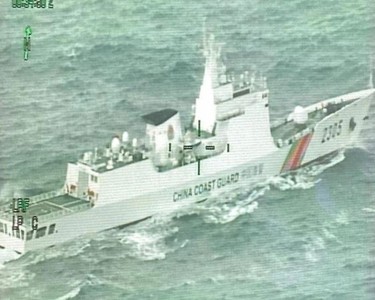
“Should we not be able to defend ourselves?” asks Michel Maisonneuve, a retired Canadian Army lieutenant-general who has served as assistant deputy chief of defence staff, and chief of staff of NATO’s Allied Command.
Article content
“Should we not be able to go up north and patrol our north correctly with submarines that actually work? Should we not be able to go destroy a balloon that China sent up by ourselves? Should we not have forward deployed bases up in our north so that we can deploy troops and aircraft and equipment up there?”
Decades of insufficient funding, painfully slow procurement and declining numbers of troops have resulted in what some have described as Canada’s “boutique” military — capable of niche operations and deployments, but not much more.
We are in a really sad state; we are unarmed and undefended right now.
Lt.-Gen. Michel Maisonneuve (ret’d)
At a time of increased tensions globally and closer to home, National Post talked to several current and former military commanders, as well as military observers, about the neglected state of Canada’s military, and what they say is needed to boost the nation’s defences and security.
“We are in a really sad state; we are unarmed and undefended right now,” said Maisonneuve. “The personnel situation is horrible. The equipment situation is horrible. The training situation is horrible. When you put all these things together, that means readiness.”
That’s a far cry from the past, when Canada was viewed as a “fireproof house,” safe from flammable materials. “I just don’t think it is fireproof anymore,” said Lt.-Gen. Steve Boivin, who heads Canadian Joint Operations Command, which is responsible for the planning, execution, support and overall command of deployed military at home and abroad.
Article content
“And I think Canadians are more and more aware of this.”

Trickle of dollars
Funding, or the lack of it, is a large part of the crisis in Canada’s military. NATO allies agreed just over a decade back to work toward spending the equivalent of two per cent of their GDP on defence. Canada has consistently fallen short of that mark.
NATO figures suggest Canada spent just 1.37 per cent of its GDP on defence in 2024. The Liberals have said they expect to reach two per cent by 2030 “at the latest.”
In his meeting with Trump, Carney promised a much greater focus on defence and security and putting Canada’s full weight into NATO, as well as securing the Arctic.
“Two per cent was the absolute minimum we should be spending. Nations are going to need to get to three per cent,” Maisonneuve said of NATO commitments.
Britain’s recent announcement that it will increase defence spending to 2.5 per cent of its GDP gives Boivin hope that Canada, as promised, will also hike military spending. “We’ve got a number of capability gaps that we need to fill,” said Boivin.
Procurement is one of them. Canada’s military has trouble buying equipment at a time when this expertise is crucial. Russia’s invasion of Ukraine, tensions between China and the United States, the ongoing conflict in the Middle East, as well as cyberattacks and disinformation should be shaking Canada out of its complacency.
Article content
“This is not a time to sit around and say, ‘Gee, I don’t know,’” said Ken Hansen, a military analyst and former Canadian naval commander. “You want people who can think outside the box, who can be active agents looking for opportunity. And unfortunately, I think the Canadian military is a very classically conservative bureaucracy … They’re not prepared to open their bathrobe.”
There’s been a proclivity for made-in-Canada solutions to try to Canadianize a lot of our platforms …
Vincent Rigby, former top intelligence adviser
Speeding up military procurement is a matter of political will, said Vincent Rigby, a former top intelligence adviser to former prime minister Justin Trudeau, who spent 14 years with Canada’s Department of National Defence. Ottawa has to decide, “this is in the interest of national security, and we’ve got to move fast,” Rigby said.
Slow procurement has been an issue for the Canadian military for decades, Rigby said. “Military procurement is, by definition, a slow process. It’s cumbersome, it has a lot of steps, a lot of due diligence. So it’s all understandable. But for many, many years in Canada, there has been … a tendency to spread the benefits of procurement across the country in terms of regional benefits. I think there’s been a proclivity for made-in-Canada solutions to try to Canadianize a lot of our platforms as much as we possibly can.”
Article content
What’s needed is more “off-the-shelf procurement,” Rigby said. As examples, he pointed to F-35 fighters (now under review), P-8 Poseidon maritime patrol and reconnaissance aircraft and Reaper combat drones, which are considered a crucial asset for modern militaries. “Stuff that we can get quickly, we can get into the battle space, (and get it) operational as soon as we possibly can.”
The U.S. problem
In mid-March, in a response to Trump’s tariff threats, Canada announced it was reviewing its $19-billion order for 88 F-35 stealth fighter jets. Canada signed the deal with U.S. defence giant Lockheed Martin in 2023 after years of delay, and put down money for the first 16 jets, due to be delivered next year. While Canada would take the 16 jets, the military would look at alternatives elsewhere for fighter jets.
“That’s a big, big, big decision if we decide we are going to cancel that contract,” Rigby said. Not only will that raise serious questions about the interoperability of the fleet of fighter jets, but also about possible reciprocity on the part of the U.S.
“Don’t forget, a lot of Canadian businesses do some serious defence co-operation with American firms, Bombardier at the top of the list. Is the Trump government going to turn around and start hitting Canadian companies? The (F-35) is one of the best fighter aircraft in the world, and so we’re not going to get necessarily the best aircraft if we go with Rafale (France) or the Gripen (Sweden) or the Eurofighter (Germany, Italy, Spain, U.K.).”
Article content
Article content
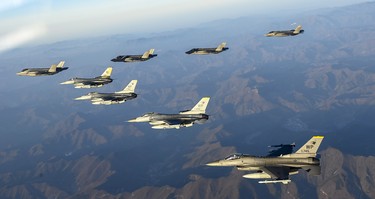
Canada needs to take the long view, Rigby cautioned. “We have to be really, really careful and we have to have contingency plans, and in a pinch, we may have to look elsewhere. But four or five years down the line, who knows where we’re going to be?
“Trump will come and go,” Rigby continued. “Who knows what we’ll get after Trump? But we’ll still be sharing the same continent with these guys. And we have a responsibility to protect the continent, to work with the U.S. on overseas operations. Don’t forget Norad here at home. We have to think about that.”
Canada has been in talks to join the European Union’s new defence initiative that would offer an alternative to buying U.S. military kit, while also boosting military industry at home. The New York Times reported the move would allow Canada to take part in building European fighter jets and other military equipment at its own industrial facilities, as well as “offer the country a new market at a time when its relationship with the United States has become frayed.”
“It’s very well-suited to the day and age that we’re in right now,” Hansen said. “It sends the signal that we are not going to take this lying down, and that there are alternatives. There are ways that we aren’t under the American thumb.”
Article content
Reinventing military procurement
Canada’s Department of National Defence has a tough time spending the dollars it is allocated by the government because of diminished management expertise in military procurement. According to defence analyst David Perry, who heads the Canadian Global Affairs Institute, the Canadian Armed Forces (CAF) returns between hundreds of millions and over a billion dollars annually to central treasury.
“We can’t spend the money because we don’t have enough people. We don’t have enough people managing the projects,” said Paul Mitchell, a professor at the Canadian Forces College in Toronto.
Canada’s military needs to undo a lot of the damage done to the organization by a credo enforced starting 20 years ago that “every service person is a soldier first” and should be able to pass the combat fitness exams, Hansen said. “The military, finally, after many years, is walking away from that and using people where they can fit and perform adequately.”
Defence cutbacks often targeted headquarters staff, including those employed in industrial estimating and contract program management. Now, the military is paying for it in terms of procurement experts. “We need hundreds of them,” Hansen said.
Article content
He suggested the Canadian military should copy the American tactic of placing officers in fellowship appointments with large companies to learn more about procurement.
Their job: “Learn everything you can, stick your nose in everywhere, go around and meet people, buy a lot of coffee, go to dinners and lunches.” When U.S. officers — usually majors and lieutenant-colonels — return from those placements, “they get plunked into an industrial procurement program,” Hansen said.
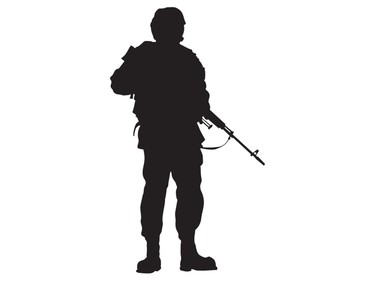
Lessons from Ukraine: Mass matters
Russia’s invasion of Ukraine is a stark reminder that a 21st-century war remains casualty-intensive — that mass matters. “You still need troops on the ground,” said Rigby.
And Canada has a very small military. By the end of last year, the Canadian Armed Forces had 64,461 regular force members and about 23,177 reservists. It hopes to reach 71,500 regular force members, and 30,000 reservists by 2032 to ease the current shortfall of about 13,862 people.
In the years before Ukraine, the Canadian military was focused on counterterrorism and counter-insurgency. “It wasn’t like the old days of the Cold War when we were prepared to go across and defend against the Soviet hordes coming across,” said Maisonneuve.
Article content
“We’re relearning some of that stuff,” he said, pointing out that the Canadian-led brigade in Latvia worked last fall on how to mount a defence against the Russians.
The number of Canadians in uniform went into free fall during the pandemic, said Mitchell. “We stopped recruiting. We stopped bringing people in because you couldn’t do the training.”
Sex scandals involving some of the military’s top brass, and a rotating door of chiefs of defence, didn’t help.
“The public image of the Canadian Forces went from very high coming out of Afghanistan, to very low, and that obviously had an impact on recruiting where people said, ‘I’m not sure that I want to belong to an organization that seems to be in such chaos at the moment,’” said Mitchell.
A recent survey of more than 24,000 post-secondary students from across the country shows less than one per cent of them (188) ranked the Canadian Armed Forces as their No. 1 preferred employer after graduation, and just over three per cent (829) identified the organization as among their top five choices.
“If it’s a major regional war that Canada gets involved in, then maybe you’d be looking at conscription and that would beef up the size of your force,” said Rigby. “We’ve seen what the Russians have resorted to in terms of keeping their numbers up, and the Ukrainians as well.”
Article content
The same radical thinking applies to Canada’s supply of military equipment and munitions. The three-year-old Russia-Ukraine war “raises questions about our defence industrial base and our need to be able to not rely exclusively on allies,” Rigby said.
Article content
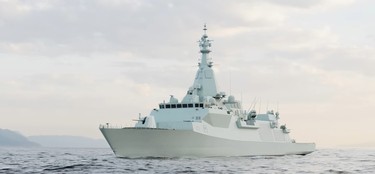
Made-in-Canada warships
Recent tensions with the United States haven’t stopped Canada from buying U.S. military equipment altogether.
Three new River-Class warships Canada recently announced it is buying will be equipped with the “latest and greatest version” of an American long-range antiballistic missile system known as Aegis, Hansen said.
In March, Ottawa pegged the cost to build and deliver the first three of 15 ships at $22.2 billion. The River-Class destroyers will be built by Irving Shipbuilding Inc.
“This new ship has whetted the navy’s appetite for capabilities they’ve never had before — the ability to shoot down ballistic missiles and engage in ballistic missile defence in an active way. That’s a big new capability and that ship is going to be a beast,” Hansen said. “I wonder if it’s even going to fit in our (Halifax) dockyard.”
Critics have warned that Americans can control the systems, which allow for “collaborative engagement.” That means any ship in a multinational task group could employ the weapons on the Canadian vessel to target an incoming threat.
Article content
“If it is the only source of what is assessed to be a critically important technology, then you really haven’t got much choice,” Hansen said.
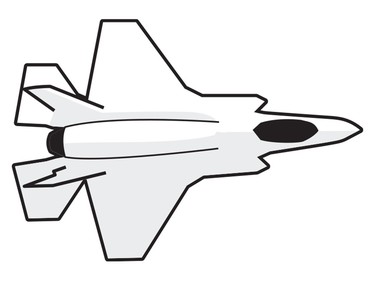
Next wave of fighter jets
Critics have also raised fears that if Canada goes ahead with buying a full fleet of 88 F-35s from Lockheed Martin, the U.S. would have full control over the upgrades and software improvements needed to keep the warplanes running.
Carney has said Canada is eyeing alternatives to the F-35. The “fifth-generation” stealth aircraft, equipped with advanced avionics and sensors, is touted by Lockheed Martin as the “most lethal, survivable and connected fighter jet in the world.”
Dassault’s Rafale fighter jet, the Eurofighter Typhoon — developed by a consortium including Airbus, BAE Systems and Leonardo — as well as Saab’s Gripen were all in competition for Canada’s business before the F-35s made the final cut.
Whatever replaces Canada’s aging CF-18 fleet must be able to operate in all weather conditions, engage in a wide range of air-to-air and air-to-surface missions, and be interoperable with coalition partners.
“The Swedes say that you could do all of that with the Gripen,” Hansen said, noting the aircraft was the runner-up in the competition that eventually settled on the F-35 in 2023.
Article content
Nova Scotia’s IMP Group was part of a consortium bidding to put together and maintain Saab’s Gripen fighter jets at the company’s massive hangar near Halifax Stanfield International Airport.
“I think stealth warplanes (like the F-35) are going to be a temporary phenomenon, and that you really shouldn’t be spending everything all at once to get a technology that, in the fullness of time, will turn out to be either obsolescent or flat-out obsolete,” Hansen said.
Drone warfare
In a world first, a Ukrainian seaborne drone reportedly destroyed a Russian fighter jet at the beginning of May. The 5.5-metre drone fired a surface-to-air missile at the $50-million jet, causing it to catch fire and crash. Unmanned drones have come to define modern warfare.
Canada’s military needs to redirect intelligence gathering into “technology areas that have probably not been explored very much in the past, like the use of drones and paper gliders that carry bombs,” said Hansen.
The Ukrainians have built a cardboard plane that has a wingspan of about a metre, “with a little wee engine in front of it, and it carries a five-pound bomb,” Hansen said. “Because they’re built out of cardboard and glue, the Russian radar can’t detect them.”
Article content
When it gets within range of its target, it shuts the engine off and may even eject the propeller blade because those could reflect Russian radar signals.
“It glides down to the target and explodes,” Hansen said. “They’re painted a very light tan colour with a little bit of blue on the underside — very difficult to see.”
Those have proved very effective, he said. “A five-pound bomb, if it flew into your office, would ruin everything in it.”
The maritime drones have been real game-changers.
Paul Mitchell, Canadian Forces College in Toronto
Ukraine is now employing drones that can be controlled with electro-optic fibres “about the thickness of a human hair,” and have a range of four or five miles, said the former naval commander. “It can’t be jammed electronically.” The drones “can scoot around enemy defences and whomp them in the rear.”
Ukraine’s small marine drones can hide in the clutter that radar returns when it’s examining things at the wave-top levels, explained Mitchell, the professor.
“These things can get really close in before they’re noticed, and then by the time they’re noticed, it’s really hard to turn a self-defence weapon on to them.”
That’s how the less-resourced Ukrainians have been able to drive off the Russian navy, Mitchell said. “The maritime drones have been real game-changers.” The sunk cost is low, and the personnel costs are minimal, he said. “The effectiveness of these things is rather high.”
Article content
Article content
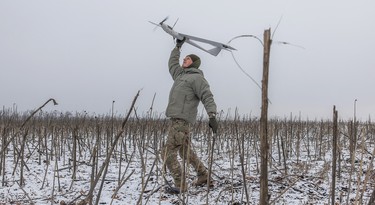
There has also been an evolution of weapons systems that can be mounted on military vehicles to defend against drone attacks, Hansen said, noting Germany produces one that is armed with twin 30-mm cannons.
“On top of the turret of this thing is a rotating radar dish (that can detect incoming drones),” he said. “It’s a lot like a naval gun on a land vehicle, and they’re very effective at shooting down drones.”
The Ukrainians have modified their Neptune anti-ship missile — its original version sank the Russian Black Sea Fleet flagship Moskva in April 2022 — and fired it recently against Russian oil refineries.
“It has a range of 1,000 kilometres,” Hansen said. “It is flying to co-ordinates that cannot be jammed. It has to be shot down. And good luck with that, because it flies at about 900 miles an hour.”
Drone technology and weapons to counter them are something “we can’t afford not to learn,” Boivin said. The brigade now in Latvia has some weapons aimed at countering the threat from incoming drones by jamming their sensors or shooting them down, said the commander.
“We’ve got some that are still to be delivered in order to give us the capabilities to address threats from unmanned aerial systems.”
Article content
Last summer, Canada awarded three “Diamond in the rough” cash prizes to companies making equipment to detect and defeat such threats. Vancouver’s AIM Defence took home the million-dollar first prize. Sherbrooke, Que.’s DARIT Technologies, and Toronto’s Prandtl Dynamics tied for second place in the contest — dubbed a Sandbox event at Alberta’s CFB Suffield — that featured 15 outfits from five countries demonstrating and testing their counter-drone technologies.
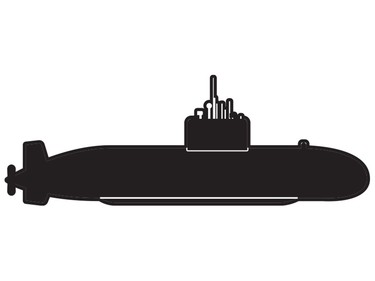
Under the ice
“We need subs,” said Boivin. “We need to be able to operate and get a full maritime domain awareness and capability.”
Submarines are especially useful when an enemy is using drones and air threats to keep surface fleets away from their shores.
“That’s when a submarine comes in really, really handy, to be able to close in to those very dangerous areas,” Mitchell said. “We need to have that capability in Canada if we’re going to project force overseas, even if it’s only to provide a proper training environment for our surface fleet.”
Submarines that can conduct under-ice operations will also play a role in Canada’s security. “I think we need 12. Whether the navy can actually man 12 submarines is a big question. They certainly can’t do it right now,” Mitchell said.
Article content
And he still sees a need for icebreakers to protect Canada’s Arctic. “We’ve got to be able to control those waters ourselves and icebreakers are what we need to do that.”
The federal government has announced plans to construct two new Arctic icebreakers for the Canadian Coast Guard. The first contract, worth $3.2 billion, went to Vancouver-headquartered Seaspan. The second icebreaker will be built in Levis by Quebec shipbuilder Davie as part of a $3.3-billion deal.
Article content
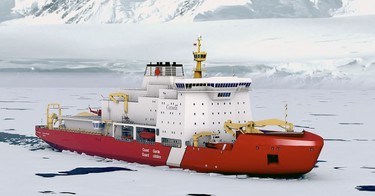
Securing the North
Where the polar ice caps once provided physical protection, the region is now opening to the world as it warms, notes Canada’s Arctic Foreign Policy. “In the coming decades, the Arctic Ocean will become a vital shipping route between Europe and Asia, while vast stores of natural resources become increasingly accessible. This growing access is already enticing nations to the region, heightening security challenges and geopolitical competition,” the policy reads.
“I think that you’re going to see us doubling down on the Arctic,” Boivin said.
Carney recently announced Canada is working with Australia to build a $6-billion early-warning radar system to cover airspace from the U.S. border to the Arctic. And in his recent meeting with Trump in the Oval Office, the prime minister promised a “much greater focus on defence and security, securing the Arctic and developing the Arctic.”
Article content
Boivin is concerned with the increased friction playing out over the Arctic between Russian and American aircraft, as well as our own. “This is why we’re completely revamping how we approach Operation Nanook,” he said, referring to a defence exercise the Canadian military carries out as often as five times a year to develop more expertise in the challenging environment.
The CAF is “taking it from a sovereignty operation to an all-domain operation where we’re going to bring in land, aerospace, maritime, cyber and space capabilities on a near-permanent basis,” Boivin said.
The idea is “to detect, deter and, if required, defend,” he said, noting the U.S. and other allies have expressed an interest in participating in the Nanook operation.
Readiness
There’s no question that facing future security challenges means the modernization of Canada’s military supply, to not only fill the gaps of military kit, but also support the equipment Canada does have.
“We don’t have enough people, we don’t have enough kit, we don’t have enough spares. So everything goes on the first bolt and then there’s nothing left over,” said Mitchell. “There’s very little resilience in the system right now.”
And that leaves Canada running a “boutique military,” the professor said.
Article content
Article content
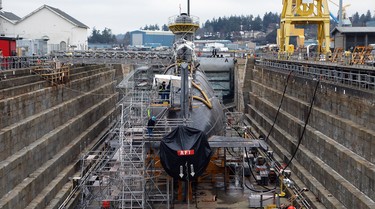
Maintenance problems plague military equipment that includes submarines, aircraft and the army’s rolling stock. “I have never seen it as bad as it is now,” said Maisonneuve. Lots of Canadian military equipment “is parked by the fence right now because there are not enough spare parts to fix them.”
Boivin worries about the declining rate of military equipment that is supposed to be ready for training and operations. Key naval fleets that are serviceable to meet training and readiness requirements in support of concurrent operations dropped below 50 per cent in 2022-2023, as did key army fleets. Serviceability rates for air force fleets increased slightly but were also way off target.
“The reality is I’m privileged as a commander that the serviceability rate of the equipment that the services give me to employ on operations is high,” said Boivin. His concern is about the equipment left back in Canada for training the brigades at home.
“I believe we’re always going to be in a position where there are some challenges,” said the commander.
“We’ve got quality people. We simply need to give them quality equipment, train them properly, and I’m very confident that we’ll do well in the operating environment.
“Every day we’ve got dedicated Canadian Armed Forces members that are delivering crazy good effects for the country on all of the operations that we have,” Boivin said, pointing to the successful helicopter rescue recently of 20 sailors from a ship grounded off Newfoundland as an example.
“I don’t think we’re a broken military,” the commander said.
Illustrations: Brice Hall / National Post
Article content





Comments